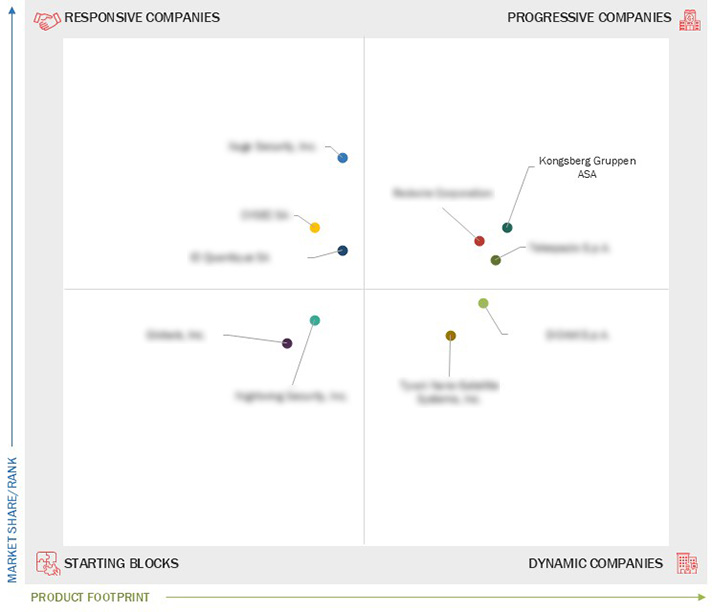Comparing 10 vendors in Space Cybersecurity Startups across 0 criteria.
The space cybersecurity market includes all measures and technologies designed to protect space-based assets like satellites, ground stations, and other space infrastructure from cyber threats. This market covers the development and deployment of solutions that ensure the security of data transmission, communication networks, and mission-critical operations. It addresses the unique challenges posed by the space environment, including distance, harsh conditions, and the strategic importance of space assets.
Market Leadership Quadrant
1.1 Study Objectives
1.2 Market Definition
1.3 Study Scope
1.3.1 Markets Covered and Regional Scope
1.3.2 Inclusions and Exclusions
1.3.3 Years Considered
1.4 Currency Considered
1.5 Unit Considered
1.6 Limitations
1.7 Stakeholders
2.1 Introduction
2.2 Market Dynamics
2.2.1 Drivers
2.2.1.1 Increase in cyber threats on space assets
2.2.1.2 Increasing militarization of space and defense initiatives
2.2.1.3 Growing dependency on satellite infrastructure
2.2.1.4 Demand for satellite-to-ground communication security
2.2.2 Restraints
2.2.2.1 Complexity of securing multi-orbit and multi-vendor space systems
2.2.2.2 Resistance to security integration in legacy space infrastructure
2.2.3 Opportunities
2.2.3.1 Growth in cyber-resilient satellite manufacturing
2.2.3.2 Emergence of space-specific, zero-trust architecture
2.2.3.3 Integration of post-quantum cryptography into space networks
2.2.4 Challenges
2.2.4.1 Data security challenges in inter-satellite communication links
2.2.4.2 Complexity in real-time cybersecurity threat response in space
2.3 Trends/Disruptions Impacting Customer Business
2.4 Value Chain Analysis
2.5 Ecosystem Analysis
2.6 Investment and Funding Scenario
2.7 Technology Analysis
2.7.1 Key Technologies
2.7.2 Complementary Technologies
2.7.3 Adjacent Technologies
2.8 Patent Analysis
2.9 Trade Analysis
2.10 Porter’s Five Forces Analysis
2.10.1 Threat of New Entrants
2.10.2 Threat of Substitutes
2.10.3 Bargaining Power of Suppliers
2.10.4 Bargaining Power of Buyers
2.10.5 Intensity of Competitive Rivalry
3.1 Introduction
3.2 Key Player Strategies/Right to Win
3.3 Revenue Analysis
3.4 Market Share Analysis
3.5 Company Valuation and Financial Metrics
3.6 Brand/Product Comparison
3.7 Company Evaluation Matrix: Startups/SMEs
3.7.1 Progressive Companies
3.7.2 Responsive Companies
3.7.3 Dynamic Companies
3.7.4 Starting Blocks
3.7.5 Competitive Benchmarking: Startups/SMEs
3.7.5.1 Detailed list of key startups/SMEs
3.7.5.2 Competitive benchmarking of key startups/SMEs
3.8 Competitive Scenario
3.8.1 Product Launches
3.8.2 Deals
3.8.3 Other Developments
4.1 Kongsberg Gruppen ASA
4.1.1 Business overview
4.1.2 Products/Solutions/Services offered
4.1.3 Recent developments
4.2 Telespazio S.p.A.
4.2.1 Business overview
4.2.2 Products/Solutions/Services offered
4.2.3 Recent developments
4.3 Redwire Corporation
4.3.1 Business overview
4.3.2 Products/Solutions/Services offered
4.3.3 Recent developments
4.4 Xage Security, Inc.
4.4.1 Business overview
4.4.2 Products/Solutions/Services offered
4.4.3 Recent developments
4.5 CYSEC SA
4.5.1 Business overview
4.5.2 Products/Solutions/Services offered
4.5.3 Recent developments
4.6 ID Quantique SA
4.6.1 Business overview
4.6.2 Products/Solutions/Services offered
4.6.3 Recent developments
4.7 Tyvak Nano-Satellite Systems, Inc.
4.7.1 Business overview
4.7.2 Products/Solutions/Services offered
4.7.3 Recent developments
4.8 D-Orbit S.p.A.
4.8.1 Business overview
4.8.2 Products/Solutions/Services offered
4.8.3 Recent developments
4.9 Globals, Inc.
4.9.1 Business overview
4.9.2 Products/Solutions/Services offered
4.9.3 Recent developments
4.10 Nightwing Security, Inc.
4.10.1 Business overview
4.10.2 Products/Solutions/Services offered
4.10.3 Recent developments


 The Maritime Standard
The Maritime Standard
 Nov 2025
Nov 2025

